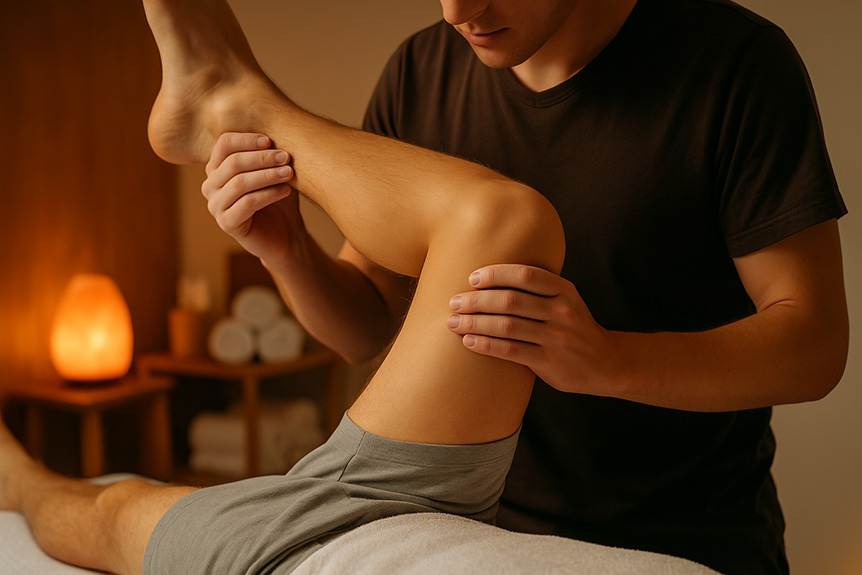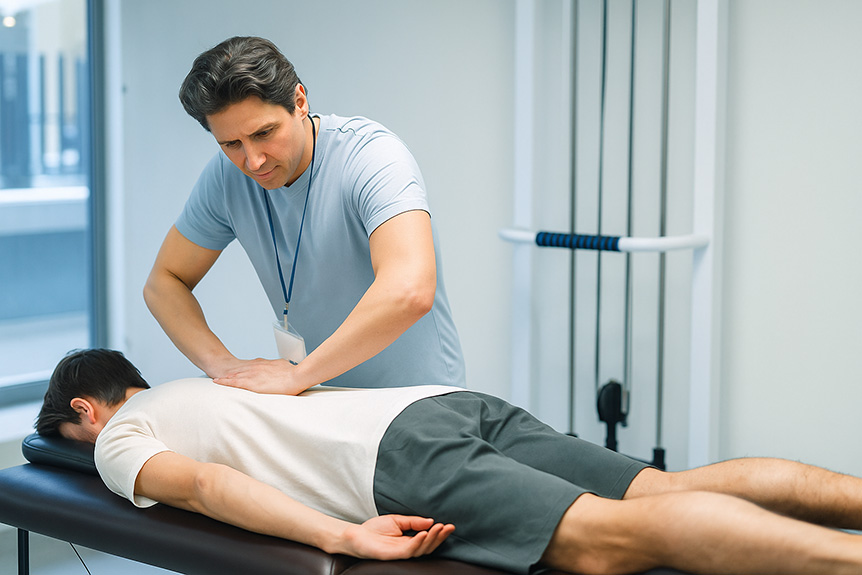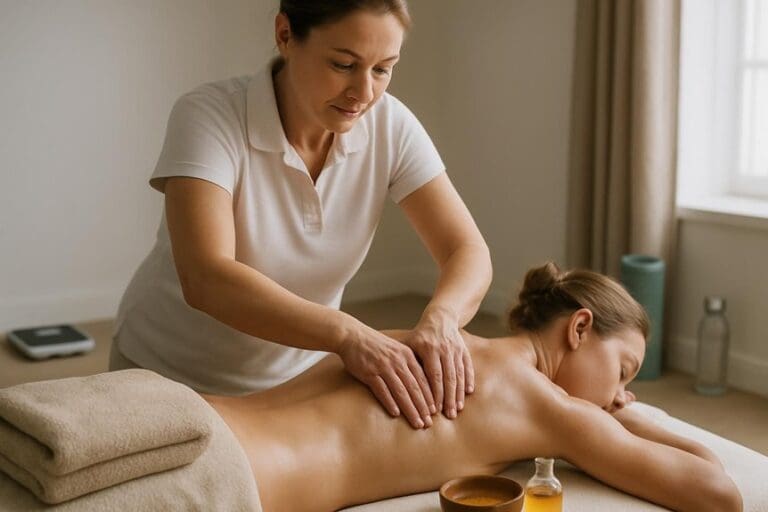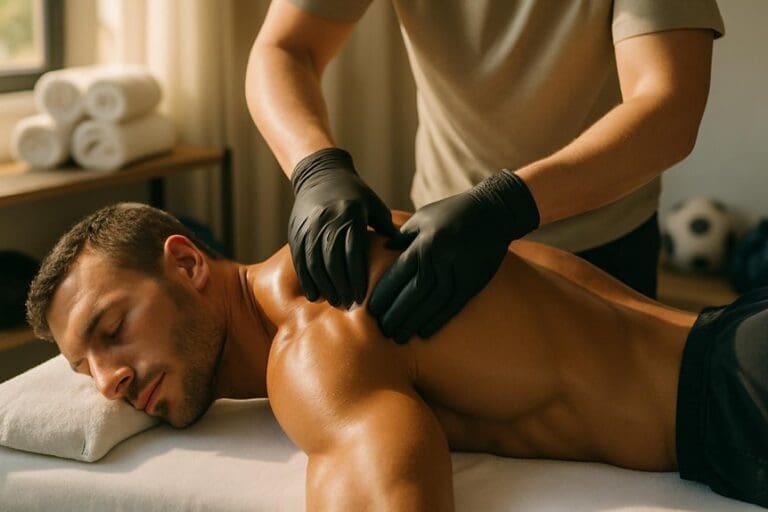This massage often involves firm, targeted pressure, especially on tight or overworked muscles, which can cause varying degrees of discomfort or mild pain. This sensation is usually described as “good discomfort” rather than sharp pain. Therapists use precise techniques such as deep tissue work and myofascial release, always adjusting pressure to suit individual tolerance and muscle response. Communication guarantees comfort and effectiveness. Many wonder about these sensations, and a thorough explanation can provide further clarity.
Understanding the Sensations of Performance Therapy

While athletic recovery massage is designed to target deeper layers of muscle and connective tissue, the sensations experienced during treatment can vary depending on individual sensitivity, the area being addressed, and the specific techniques applied.
At Spa & Massage, clients often notice a firm, purposeful pressure as therapists work through muscle adhesions and areas of tightness. This pressure may produce a sensation described as “good discomfort”—intense, yet not overwhelming, and often accompanied by a sense of relief as tension begins to release.
Some regions, particularly those with chronic tightness or recent exertion, may feel more tender under skilled hands. However, communication is encouraged so therapists can adjust pressure, ensuring the experience is effective yet respectful of each client’s comfort and boundaries throughout the session.
In some cases, complementary techniques such as the healing power of reflexology may be incorporated to further enhance relaxation and support the body’s recovery process.
Techniques Used by Our Therapists
In sports massage at Spa & Massage, therapists employ a combination of anatomically-targeted techniques designed to address muscle tension, improve mobility, and support recovery. Their approach integrates deep tissue manipulation, myofascial release, and trigger point therapy to reach beneath the surface layers of muscle.
Each movement is purposeful, following the natural contours and fiber directions of the body. Therapists use careful palpation to identify areas of tightness and apply sustained, attentive pressure only where needed. Gentle stretching and rhythmic kneading are also incorporated to promote circulation and restore suppleness.
Throughout the session, therapists maintain a close awareness of the client’s comfort, adjusting intensity as needed. This attentive, knowledgeable touch fosters trust and reassurance, delivering a therapeutic experience that supports both body and mind.
Common Areas of Discomfort and How They’re Managed
During a massage sessions, areas such as the shoulders, lower back, calves, and thighs frequently present heightened sensitivity due to accumulated tension or prior strain. These regions contain dense muscle groups and connective tissue, making them especially receptive to deep tissue techniques.
At Spa & Massage, therapists are trained to recognise the signs of discomfort—subtle shifts in muscle tone, breath, and nonverbal cues—adjusting their approach in real time. By employing slower strokes, targeted pressure, and careful palpation, discomfort is managed without compromising therapeutic benefit.
Gentle communication ensures that the client’s boundaries remain central. This attentive, anatomically-informed approach not only addresses muscular tightness but fosters trust, allowing even sensitive areas to release. Clients often notice improved mobility and a sense of ease after focused, expert care.
Tips for Minimising Discomfort During Your Session
How can discomfort be minimised to guarantee a more therapeutic performance therapy experience? Effective communication is essential—clients are encouraged to express sensitivities and preferences before and during the session.
At Spa & Massage, therapists adjust pressure and technique to accommodate individual tissue responses, focusing on gradual muscle warming and precise, anatomically-informed strokes.
Breathing deeply during intense moments helps soften muscle tension, enhancing both comfort and outcome.
Using quality massage oils, as practiced in our clinics, reduces friction and protects the skin, contributing to a gentler experience.
Strategically alternating deeper work with lighter, soothing techniques further supports relaxation.
Hydration before and after the session can also improve tissue pliability, making the massage less intense.
Each decision is tailored to nurture both body and trust.
What to Expect After Your Massage Session
What typically follows a massage is a period of physiological adjustment as the body responds to targeted muscle work. Muscles that have been manipulated may feel tender or mildly sore, as metabolic waste is flushed away and circulation increases. This response is normal and indicates the body’s healing processes are at work.
At Spa & Massage, therapists recommend gentle stretching and proper hydration following a session, supporting tissue recovery and reducing discomfort. Some clients notice increased flexibility or a light sensation of fatigue, both signs that muscle tension is dissipating.
Rarely, minor bruising may occur in deeply worked areas. Overall, clients leave with a heightened sense of awareness in their bodies, reassured by the attentive care and expert techniques employed in each treatment.
Conclusion
In conclusion, athletic recovery massage is not designed as a medieval torture device, but rather as a modern, anatomically-informed approach to muscle care. While some discomfort can occur, professional therapists at Spa & Massage skillfully tailor techniques to balance efficacy and comfort, addressing individual needs. By communicating openly and following aftercare advice, clients can maximise the therapeutic benefits while minimising discomfort. Ultimately, this massage supports ideal musculoskeletal health, helping clients move forward with resilience and confidence in their active pursuits.



